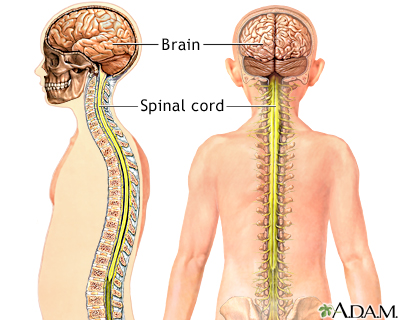Health Library
Syringomyelia
Syrinx
Syringomyelia is a cyst-like collection of cerebrospinal fluid (CSF) that forms in the spinal cord. Over time, it may damage the spinal cord.
Images

I Would Like to Learn About:
Causes
The fluid-filled cyst is called a syrinx. The spinal fluid buildup may be caused by:
- Birth defects (especially Chiari malformation, in which part of the brain pushes down onto the spinal cord at the base of the skull)
- Spinal cord trauma
- Tumors of the spinal cord
The fluid-filled cyst usually begins in the neck area. It expands slowly, putting pressure on the spinal cord and slowly causing damage.
Onset of syringomyelia is usually between 25 to 40 years old. Males are more affected than females.
Symptoms
If the condition is due to birth defects, there may be no symptoms until age 30 to 40 years. Symptoms of syringomyelia usually appear slowly and worsen over many years. In the case of trauma, the onset of symptoms may be as early as 2 to 3 months of age. If there are symptoms, they may include:
- Headache
- Scoliosis (in children)
- Loss of muscle mass (wasting, atrophy), often in the arms and hands
- Loss of reflexes in upper limbs
- Increased reflexes in lower limbs
- Spasms or tightness in the leg or hand and arm muscles
- Muscle function loss, loss of ability to use arms or legs
- Numbness that decreases the feeling of pain or temperature; lowers the ability to feel when the skin is being touched; occurs in the neck, shoulders, upper arms, and trunk in a cape-like pattern; and slowly gets worse over time
- Pain down the arms, neck, or into the middle back or legs
- Weakness (decreased muscle strength) in the arms or legs
- Painless burn or injury of the hand
- Difficulty walking or toe walking in children
- Uncontrollable movements of the eyes (nystagmus)
- Condition that affects the nerves to the eye and face (Horner syndrome)
- Trouble controlling the bowel or bladder
Exams and Tests
Your health care provider will perform a physical exam and ask about the symptoms, focusing on the nervous system. Tests that may be done include:
- MRI of the head and spine
- Spinal CT scan with myelogram (may be done when an MRI is not possible)
Treatment
There is no known effective treatment for syringomyelia. The goals of treatment are to stop the spinal cord damage from getting worse and to improve function.
Medicines and devices can help with pain.
Surgery may be needed to relieve pressure in the spinal cord. Physical and occupational therapy may be needed to improve muscle function and help maximize independence.
Ventriculoperitoneal shunting or syringosubarachnoid shunting may be needed. This is a procedure in which a catheter (thin, flexible tube) is inserted to drain the fluid buildup.
Other treatments are available to manage bowel and bladder problems and spasticity.
Outlook (Prognosis)
Without treatment, the disorder may get worse very slowly. Over time, it may cause severe disability.
Surgery usually stops the condition from getting worse. Nervous system function will improve in about 30% of the people who have surgery.
Possible Complications
Without treatment, the condition may lead to:
- Loss of nervous system function
- Permanent disability
Possible complications of surgery include:
- Infection
- Other complications of surgery
When to Contact a Medical Professional
Contact your provider if you have symptoms of syringomyelia.
Prevention
There is no known way to prevent this condition, other than avoiding injuries to the spinal cord. Getting treated right away slows the worsening due to this disorder.
Related Information
Spinal cord traumaReferences
Alobeidi F, Thurnher MM, Jäger HR. Non-tumoural spinal cord lesions. In: Adam A, Dixon AK, Gillard JH, Schaefer-Prokop CM, eds. Grainger & Allison's Diagnostic Radiology. 7th ed. Philadelphia, PA: Elsevier; 2021:chap 50.
Benglis DM, Jea A, Vanni S, Shah AH, Green BA. Syringomyelia. In: Garfin SR, Eismont FJ, Bell GR, Fischgrund JS, Bono CM, eds. Rothman-Simeone and Herkowitz's The Spine. 7th ed. Philadelphia, PA: Elsevier; 2018:chap 94.
National Institute of Neurological Disorders and Stroke website. Syringomyelia. www.ninds.nih.gov/health-information/disorders/syringomyelia. Reviewed September 23, 2023. Accessed July 3, 2024.
Roguski M, Groves ML. Adult syringomyelia. In: Winn HR, ed. Youmans and Winn Neurological Surgery. 8th ed. Philadelphia, PA: Elsevier; 2023:chap 334.
BACK TO TOPReview Date: 6/13/2024
Reviewed By: Joseph V. Campellone, MD, Department of Neurology, Cooper Medical School at Rowan University, Camden, NJ. Review provided by VeriMed Healthcare Network. Also reviewed by David C. Dugdale, MD, Medical Director, Brenda Conaway, Editorial Director, and the A.D.A.M. Editorial team.
 | A.D.A.M., Inc. is accredited by URAC, for Health Content Provider (www.urac.org). URAC's accreditation program is an independent audit to verify that A.D.A.M. follows rigorous standards of quality and accountability. A.D.A.M. is among the first to achieve this important distinction for online health information and services. Learn more about A.D.A.M.'s editorial policy, editorial process and privacy policy. A.D.A.M. is also a founding member of Hi-Ethics. This site complies with the HONcode standard for trustworthy health information: verify here. |
The information provided herein should not be used during any medical emergency or for the diagnosis or treatment of any medical condition. A licensed medical professional should be consulted for diagnosis and treatment of any and all medical conditions. Links to other sites are provided for information only -- they do not constitute endorsements of those other sites. No warranty of any kind, either expressed or implied, is made as to the accuracy, reliability, timeliness, or correctness of any translations made by a third-party service of the information provided herein into any other language. © 1997- 2024 A.D.A.M., a business unit of Ebix, Inc. Any duplication or distribution of the information contained herein is strictly prohibited.
